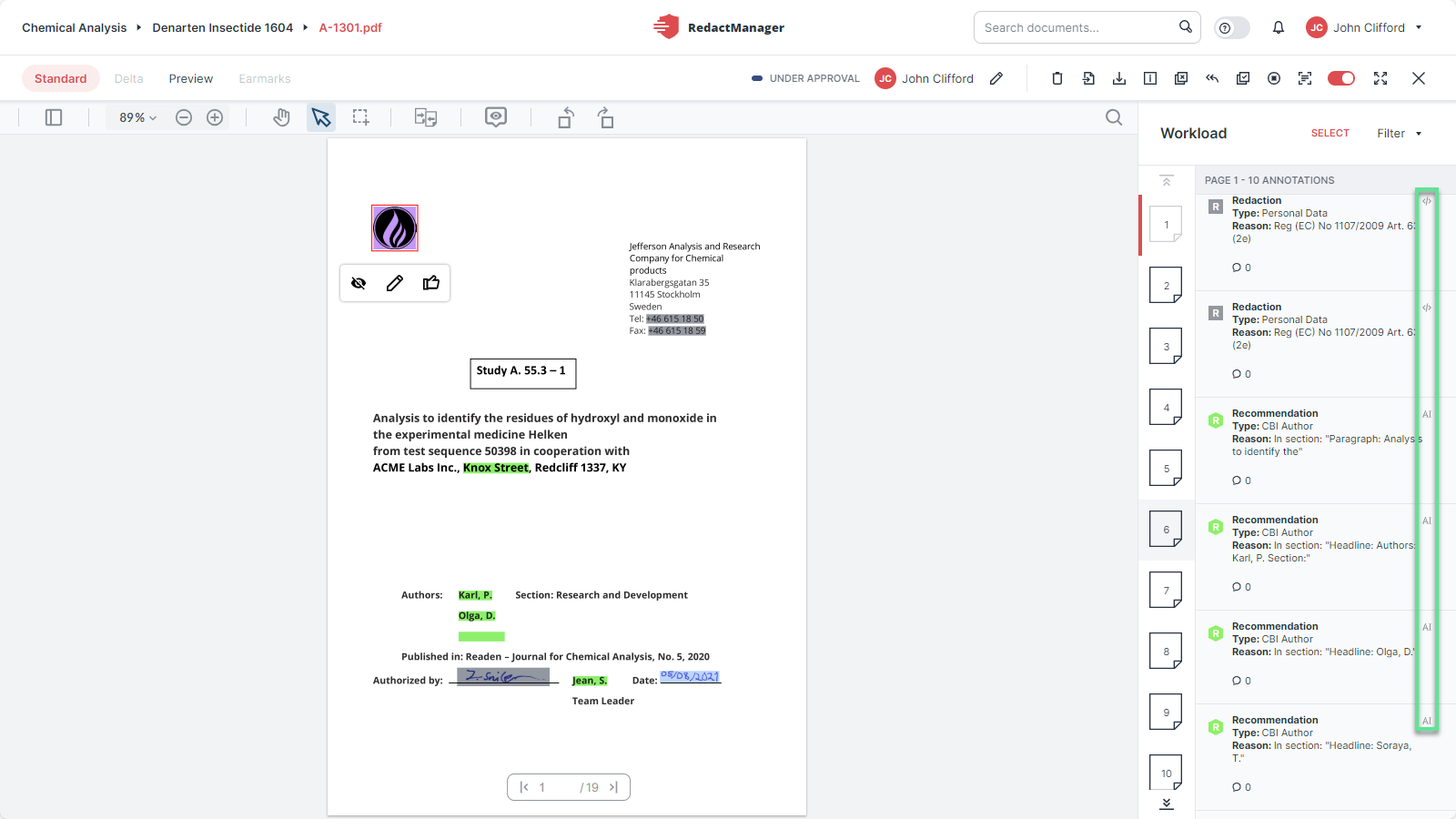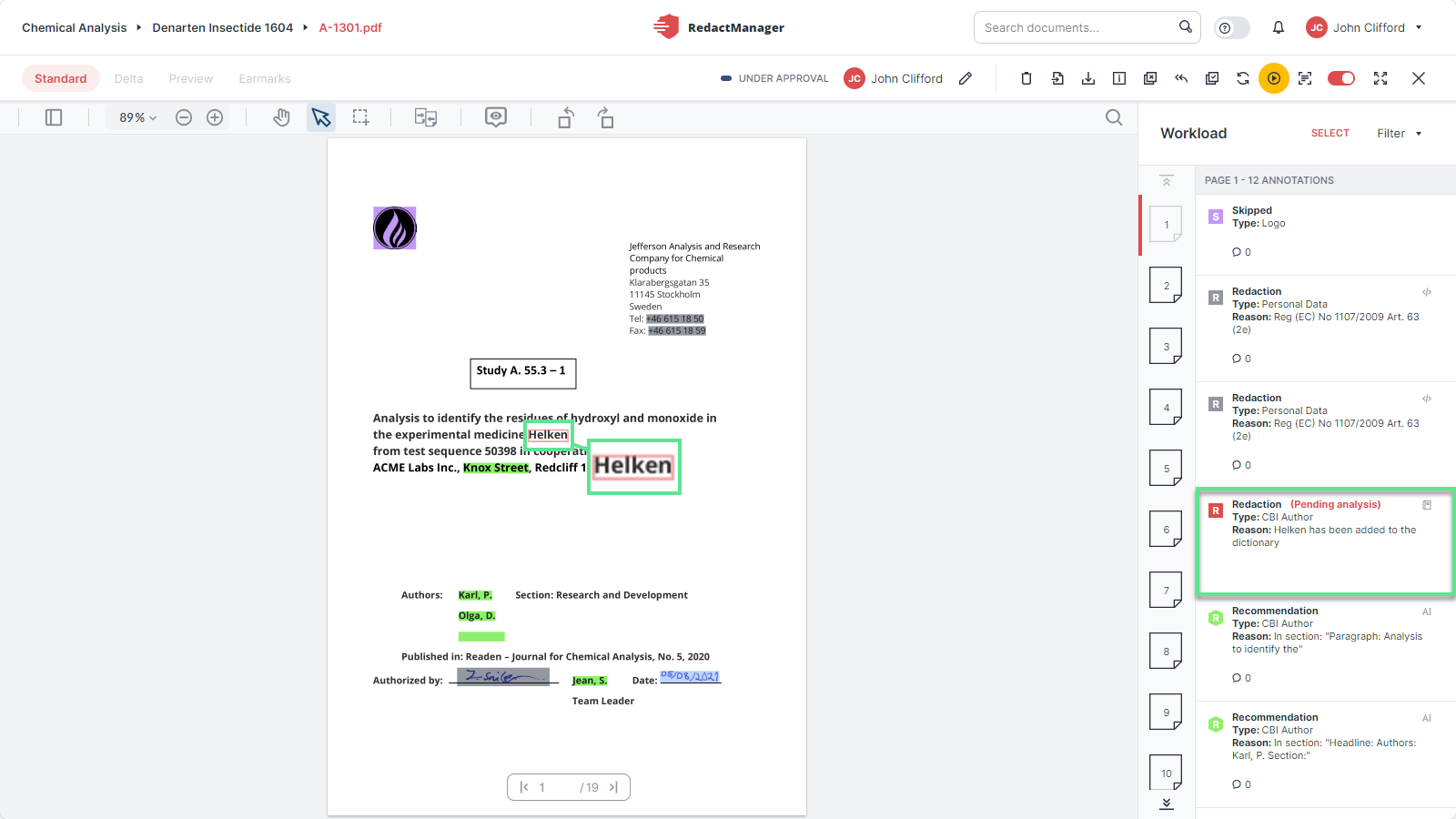Annotations
RedactManager annotates (highlights) sensitive information during the document analysis based on the information stored in the system, the defined rules, or the AI model. The terms stored in the system can consist of one or multiple words.
Annotation conditions
When will stored terms be annotated in a document?
RedactManager annotates/redacts stored terms when it finds the exact term between word delimiters, i.e. RedactManager only matches entire terms.
A term will not be annotated/redacted if it appears as part of another term. (However, you can redact it manually in this case.)
While working on a document, you can use the "Redact in dossier" and "Apply to all dossiers" features to store parts of words to the system. The term will be annotated/redacted if it is found as a whole.
Annotation types
The highlighting color of an annotation indicates the annotation type and shows whether the annotated text passage will be redacted in the final document. The highlighted annotations are also shown in the workload. The admin can define the colors.
RedactManager distinguishes the following annotation types:
Annotation type | Description |
|---|---|
Redaction | Redactions are generated automatically based on the rule sets. Some other annotation types can be converted into redactions. The respective passage will be redacted in the final document. |
Manual redaction | The reviewer and the approver can manually add text or rectangle redactions to the document, which are labeled as manual redactions. The highlighted passage will be redacted in the final document. |
Skipped redaction | Some sensitive data does not need to be redacted in certain contexts. RedactManager nevertheless highlights it as "skipped (redaction)" to show that the sensitive information has been identified and will be intentionally left unredacted. Example: Author names do not need to be redacted in studies submitted to compliance bodies if their work has already been published. The respective text passage will still be annotated and labeled as skipped. When a term is stored at a higher level in the system than the one from which you remove it, the redaction will be displayed as "skipped redaction". That allows you to keep track of removals in active dossier documents. Cases:
The highlighted passage will not be redacted in the final document, but you can force the redaction if needed. |
Imported redaction | RedactManager labels the following as imported redactions:
The highlighted passage will be redacted in the final document. |
Hint | Hints highlight helpful information. RedactManager distinguishes the following types of hints:
The highlighted passage will not be redacted in the final document. |
Ignored hint | When you carry out a local hint removal ("Remove only here"), the hint turns into an ignored hint. This helps you to keep track of changes. |
Recommendation | RedactManager generates redaction recommendations based on its AI models and the rules defined in the dossier templates. The highlighted passage will not be redacted in the final document. You can accept recommendations to convert them into redactions so that they will be redacted in the final document. |
Annotation origin
The icons at the top right of the workload tiles show on which basis a redaction, note, skipped, etc. was generated and whether it was edited manually.

Origin icons
Manual changes
:
The manual changes icon is displayed if any of the following actions with local effect were carried out on the annotation:
Redaction / Hint / Skipped based on the dictionary
:
RedactManager generated the annotation based on a dictionary entry. This means the term was previously stored in the system by an admin or via the Redact in dossier/Apply to all active and future dossiers functionality.
Redaction / Hint / Skipped based on the dossier dictionary
:
RedactManager generated the annotation based on the dossier dictionary. This means the term was previously stored in the dossier dictionary by a dossier member via the Redact in dossier functionality.
Redaction / Hint / Skipped based on AI
:
RedactManager generated the annotation with the help of artificial intelligence (AI).
Redaction / Hint / Skipped based on rule
:
RedactManager generated the annotation based on a rule that has been defined in the respective dossier template.
Redaction was imported
:
The redaction was imported by a user from a preview, redacted or earmarked document.
Annotation references 
The See references icon shows that an annotation is related to other annotations. This option is only displayed in the workload and is currently only available if a skip or a hint is related to other annotations.
When to select this option:
You want to see if there is an annotation that affects the given annotation.
Result of this action:
A small pop opens. It lists the annotations and page numbers related to the given annotation.
The references may currently be hints pointing to publicly available information that makes the redaction of the sensitive data unnecessary and causes the skipping of a redaction.
Click on one of the listed references to jump to the respective annotation.

References list
If you want to show references for other annotation types, e. g. redactions or recommendations, please contact your knecon representative.
Pending analysis
When the auto-analysis is disabled, changes on dossier level or higher (Redact in dossier / Remove from dossier) are not applied.
Until auto-analysis is restarted, the affected term is highlighted with a red box that is displayed only at the position in the document where you performed the action. The other positions will be identified during reanalysis.
The workload entry is also only created at this point and marked as "Pending analysis".

Pending analysis entries in the workload and document
Pending redactions will not be redacted in the final document nor listed in the respective redaction reports. The change will be applied when you start the auto-analysis or a single analysis run.